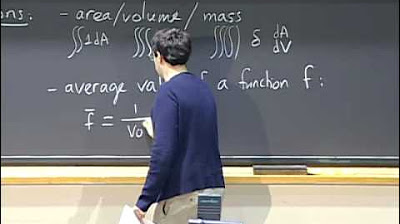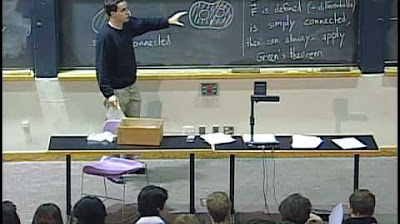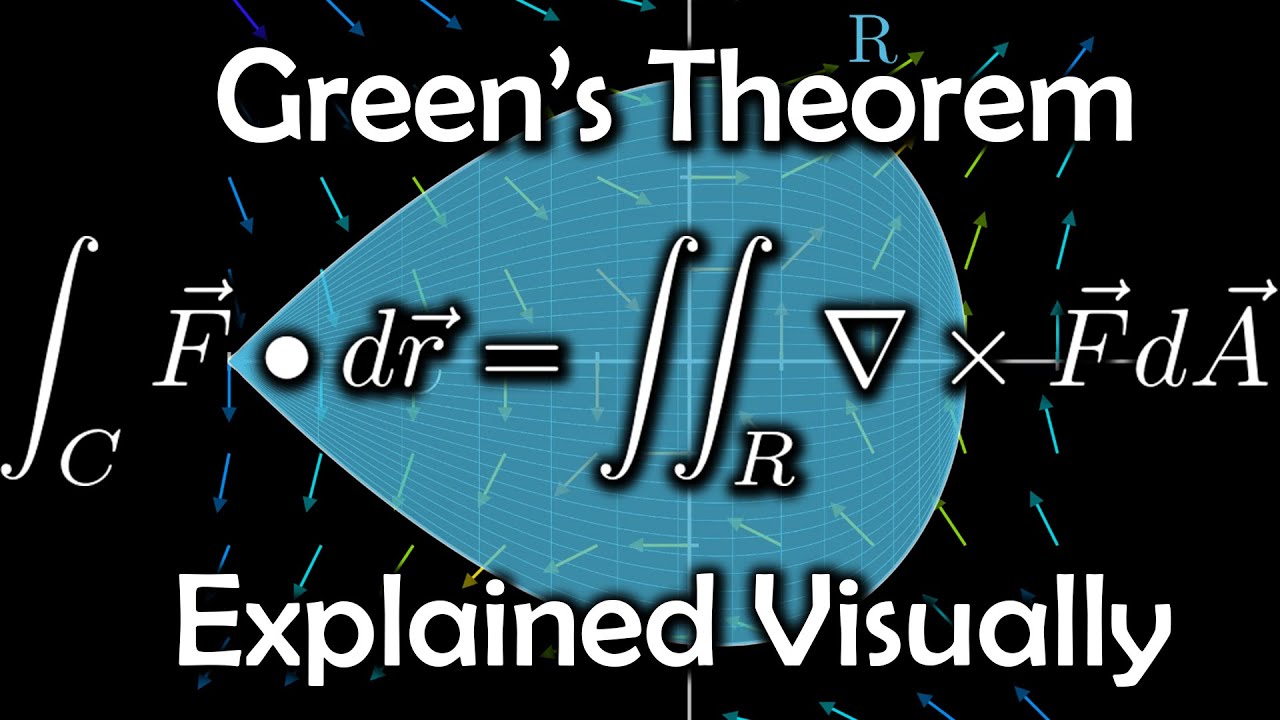Stokes' Theorem and Green's Theorem
TLDRThis video script delves into Stokes's and Green's theorems, fundamental concepts in vector calculus. It explains how these theorems relate surface integrals of a vector field's curl to contour integrals, akin to Gauss's divergence theorem. Stokes's theorem is particularly highlighted for its utility in physical applications, such as fluid dynamics and aerodynamics, where it quantifies angular momentum or vorticity. The script also creatively demonstrates how Green's theorem can be applied to calculate the area of irregular land parcels, offering practical insights into these mathematical principles.
Takeaways
- 📐 Stokes's Theorem and Green's Theorem relate surface integrals of the curl of a vector field to contour integrals around an enclosing contour.
- 🌍 Stokes's Theorem involves surface integrals of the curl of a vector field over a surface and is useful for physical quantities in partial differential equations.
- 🌀 Green's Theorem is a 2D version of Stokes's Theorem, simplifying the concept to flat surfaces and their perimeters.
- 🔄 The curl of a vector field, a measure of rotation, is integral to understanding Stokes's and Green's Theorems.
- 🖋️ Stokes's Theorem: The surface integral of the curl of a vector field over a surface equals the contour integral of the vector field along the surface's boundary.
- 📏 In 2D, Green's Theorem simplifies to the surface integral of the curl over an area equaling the contour integral around its boundary.
- 🔍 Stokes's Theorem can be visualized by decomposing the surface into small boxes where the inner curls cancel out, leaving the perimeter's contribution.
- 🚁 Stokes's Theorem is practical for analyzing fluid flows, aerodynamics, and vorticity in various physical systems.
- 🧮 Green's Theorem is useful for calculating the area of irregular shapes by integrating around their perimeter.
- 📊 Both Stokes's and Green's Theorems provide powerful tools for converting complex integrals over areas or volumes to simpler integrals over boundaries.
Q & A
What are Stokes's Theorem and Green's Theorem?
-Stokes's Theorem and Green's Theorem are vector calculus formulas that relate surface integrals of the curl of a vector field over some surface to equivalent contour integrals around an enclosing contour. They are useful for expressing physical quantities in partial differential equations and can be used to analyze phenomena like fluid flows and aerodynamics.
How does Stokes's Theorem relate to Gauss's Divergence Theorem?
-Like Gauss's Divergence Theorem, Stokes's Theorem allows for the conversion of a volume integral to a surface integral. While Gauss's Theorem deals with volume integrals of the divergence of a vector field, Stokes's Theorem is concerned with surface integrals of the curl of a vector field.
What is the significance of the 'da vector' in the context of Stokes's Theorem?
-The 'da vector' represents a vector in the normal direction of a patch on the surface with magnitude equal to the area of that patch. It is crucial in Stokes's Theorem because the curl of the vector field is dotted with this 'da vector' to account for the directionality of the curl relative to the surface.
What does the 'ds arrow' represent in the script?
-The 'ds arrow' is a tangent vector along a curve on the surface. It is a vector with x and y components (in 2D) or more in 3D, indicating the direction of the curve at every point on the surface.
What is the physical interpretation of the curl in the context of fluid dynamics?
-In fluid dynamics, the curl represents the rotation or vorticity of the fluid flow. It indicates how much the fluid is swirling around a point, which is important for understanding phenomena like the formation of hurricanes or the lift on an airfoil.
How does Green's Theorem simplify the application of Stokes's Theorem?
-Green's Theorem is essentially Stokes's Theorem applied to a flat, 2D surface. It simplifies the calculation by reducing the surface integral of the curl to a line integral around the perimeter of the surface, making it easier to compute and understand.
What is the mathematical expression for Green's Theorem?
-Green's Theorem states that the integral over a flat surface 'S' of the curl of a 2D vector field 'F' is equal to the line integral around the perimeter '∂S' of the vector field 'F' dotted into the tangential direction of the perimeter, expressed as ∮(F·ds) = ∫[(∂f2/∂x) - (∂f1/∂y)]dA.
How can Stokes's Theorem be used to compute the area of an irregular shape?
-Stokes's Theorem can be used to compute the area of an irregular shape by integrating half the quantity (x dy - y dx) around the perimeter of the shape. This method allows for the calculation of areas without breaking the shape into smaller, measurable parts.
What is the significance of the 'pillbox' decomposition in the explanation of Stokes's Theorem?
-The 'pillbox' decomposition is a visual tool used to understand how the surface integral of the curl over an entire area can be broken down into smaller components that cancel each other out, leaving only the contributions along the perimeter, which is key to the theorem's proof.
How does Stokes's Theorem relate to the conservation of angular momentum?
-Stokes's Theorem encodes the conservation of angular momentum by allowing the calculation of the total curl (or vorticity) over a surface and relating it to the circulation around the perimeter of that surface. This shows how angular momentum is conserved in rotational flows.
Outlines
📚 Introduction to Stokes's and Green's Theorems
This paragraph introduces the concepts of Stokes's theorem and Green's theorem, which are fundamental in vector calculus. It compares these theorems to Gauss's divergence theorem, highlighting their utility in relating surface integrals of the curl of a vector field to contour integrals. The explanation sets the stage for a deeper dive into how these theorems can be applied to express physical quantities in partial differential equations, specifically in the context of fluid dynamics and atmospheric flows.
🌀 Stokes's Theorem and Its Implications
The speaker elaborates on Stokes's theorem, explaining how it allows for the conversion of a surface integral of the curl of a vector field into a line integral around the boundary of the surface. The paragraph delves into the mathematical notation and concepts such as the tangent vector and the normal vector with area. It provides an intuitive understanding of how the theorem can be used to measure the strength of phenomena like hurricanes by examining the circulation or vorticity around a perimeter.
📘 Green's Theorem as a 2D Version of Stokes's Theorem
Green's theorem is introduced as a two-dimensional analogue of Stokes's theorem, applicable to flat surfaces. The explanation simplifies the concept by demonstrating how it can be used to relate a surface integral of a 2D vector field's curl to a line integral around the perimeter. The paragraph emphasizes the ease of computation and the physical interpretation of the theorem, particularly in the context of fluid dynamics and circulation around a boundary.
🔍 Physical Intuition Behind Stokes's and Green's Theorems
This paragraph offers a visual and intuitive explanation of why Stokes's and Green's theorems hold true. It uses the analogy of breaking down a surface into infinitesimal boxes to illustrate how the internal curl components cancel each other out, leaving only the components tangent to the perimeter. This visual representation helps to understand the theorems' fundamental principle that the surface integral of the curl is equivalent to the line integral of the vector field around the boundary.
🌐 Applications and Advanced Concepts of Stokes's and Green's Theorems
The final paragraph discusses practical applications of the theorems, including their relevance to aerodynamics, fluid flows over surfaces, and the computation of angular momentum in rotational flows. It also touches on the historical use of Green's theorem by surveyors to measure land areas before modern technology. Additionally, the paragraph hints at higher-dimensional generalizations of these theorems, suggesting a deeper mathematical structure that extends beyond traditional vector calculus.
Mindmap
Keywords
💡Stokes's Theorem
💡Green's Theorem
💡Vector Calculus
💡Curl
💡Surface Integral
💡Contour Integral
💡Divergence Theorem
💡Tangent Vector
💡Normal Vector
💡Conservation of Angular Momentum
💡Aerodynamic Surfaces
Highlights
Stokes's Theorem and Green's Theorem are vector calculus formulas that relate surface integrals of the curl of a vector field to contour integrals.
These theorems are useful for expressing physical quantities in partial differential equations and can be used similarly to Gauss's Theorem.
Gauss's Theorem involves volume integrals of the divergence of a vector field, while Stokes's Theorem involves surface integrals of the curl.
The surface integral in Stokes's Theorem is taken over an open surface with an edge or perimeter, denoted by partial S.
Tangent vectors and normal vectors with area are used to define the orientation and magnitude of the surface integral.
Stokes's Theorem is written in full generality, relating the surface integral of the curl to a path integral around the perimeter.
Green's Theorem is a 2D version of Stokes's Theorem, applicable to flat surfaces and their perimeters.
In Green's Theorem, the surface integral simplifies to the integral of the partial derivatives of a 2D vector field.
The theorems allow equating a large surface integral to a smaller integral around the perimeter, simplifying calculations.
Stokes's Theorem provides a way to compute the circulation or vorticity of a vector field on a surface.
The theorems can be applied to fluid flows, aerodynamics, and the study of phenomena like hurricanes.
Conservation of angular momentum is encoded in the curl, making these theorems important for rotational flows.
Green's Theorem can be used to compute the area of irregular land shapes by integrating around the perimeter.
The area computation involves integrating x dy - y dx around the boundary, which equals twice the area of the parcel.
Surveyors historically used similar methods to measure land before modern technology like GPS was available.
The theorems are not limited to flat surfaces; they can be generalized to n-dimensional manifolds.
Upcoming lectures will explore potential flow, irrotational vector fields, and further applications of these theorems.
Transcripts
Browse More Related Video

Lecture 21: The Fundamental Theorem Extended

Lec 35: Final review (cont.) | MIT 18.02 Multivariable Calculus, Fall 2007

Calculus 3 Final Review (Part 3) || Vector Calculus || Line Integrals, Green's and Stokes' Theorem

Lec 24: Simply connected regions; review | MIT 18.02 Multivariable Calculus, Fall 2007

Stokes's Theorem

Green's Theorem, explained visually
5.0 / 5 (0 votes)
Thanks for rating: